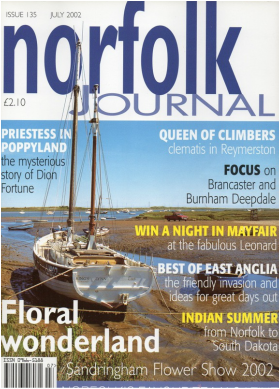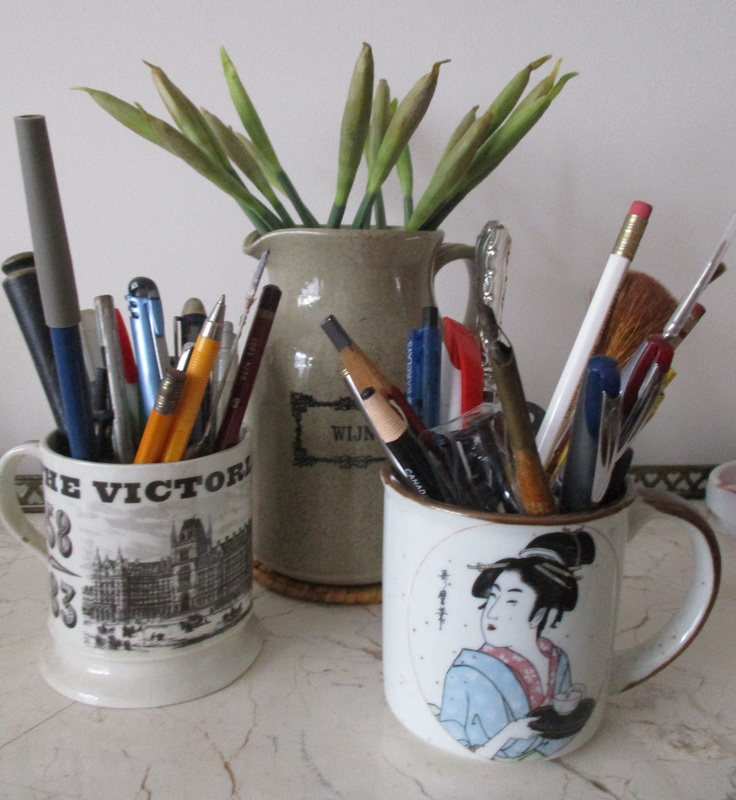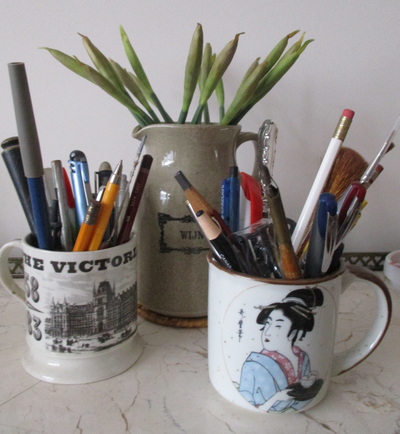|
I’m delighted to announce that Poppyland has just published my latest book, Different Drums – One Family Two Wars. Based on family papers and original research, it tells the story of conscientious objection from religious non-conformity to humanitarianism during two wars with particular relation to Norwich. A big thank you to publishers Gareth and Janet Davies for taking it on. I hope it will prove its worth amongst the excellent selection of their new spring books. The book is available in East Anglian bookshops and online through Poppyland Publishing or order though your local bookshop wherever you are (via Amazon, you will get an edition that is of lower quality paper).
 Text of Article: Copyright Victoria Manthorpe 2002 Priestess in Poppyland There were many battles fought against the Nazis on land and sea and in the air but one woman chose psychic territory for her combat zone and mustered the powers of an occult order to wage a Magical Battle for Britain. That woman was Dion Fortune, born Violet Firth (1890-1946), and her religious inspiration was crystallized in a Poppyland church. Heinrich Himmler, Hitler’s dreaded lieutenant, head of the SS and the architect of the Holocaust, believed that he was a reincarnation of King Heinrich the First. At his Grimm-fairy-tale Castle deep in the Nazi heartland Himmler enacted spurious ceremonies based on an idealization of Teutonic knights and a German Holy Grail. He and other members of the Third Reich are thought to have engaged in the rituals of black magic in order to summon up dark powers; Nazi occultism has recently become the subject of serious study as well as popular television documentaries. But, if aberrant Nazis were intent on raising the Devil, back here in Blighty, a network of quiet initiates were pottering away on Sunday afternoons with their own counter-magic. Every Wednesday about a hundred letters would be sent out to aspiring members of the “Fraternity of the Inner Light. Every Sunday between 12.15 and 12.30 the London members would gather in 3 Queensborough Terrace, Notting Hill to focus their powers, and around the country the out-of-town members would open their letters, read the topic for the day, and synchronize their meditation. The idea was to protect this sceptre’d isle against the Nazi evil with the power of psychic light. Dion Fortune who wrote the letters was firm in her belief that: “there is one thing, and one thing only that can disperse this dark cloud of ancestral evil and set the souls of Germans free, and that is the power of Christ, and we must bring this power to bear.” The methods the Fraternity were those of visualization and concentration which, fifty years ago, were secret mental exercises practised only by initiates into occult orders. Now, in line with a general opening up of hidden rites, they are widely known through New Age exercises for personal and spiritual development. Dion Fortune was one of the most important figures of Twentieth Century English occultism; from a family northern steel manufacturers, she was born in Llandudno but in her youth she had strong, if somewhat mysterious, links with Norfolk. In a quiet agricultural haven south of Swaffham in a little village called Cockley Cley some odd connections come together. It is the site of Boudicca’s headquarters from where she launched the great rebellion against the Romans. In the same village lies a tiny Christian chapel, which was thought for centuries to be just a farm cottage. Deep under the floor lies a Roman religious site and more than likely beneath that a Celtic Iceni one. Cockley Cley would appear to be an ancient holy place. By contrast Cockley Cley Hall is a straightforward red brick mansion – straight and plain on the undulating landscape. It belonged to the Combe family and devolved upon one Dorothy Combe who married Francis Stafford Allen. He was a widower and a man of considerable substance derived from the growing and manufacturing of medicinal herbs. He was in partnership with several Egyptian-based English merchants who traded general merchandise, some presumably pharmaceutical, as well as undertaking building and contracting work in Alexandria. Since the mid-1880’s Egypt had come under British domination, Lord Cromer, a Norfolk man, was the virtual ruler. But Francis Stafford Allen had more than business interests in Egypt because the story in the family is that he gave financial support to Howard Carter of Swaffham who was later to excavate Tutankhamen’s tomb. The occult thrives on connections of this kind, both real and figurative; Egypt is the seminal source of much Western religious wisdom. Stafford Allen had three grown up daughters from his first marriage who retained their connections with Norfolk. Elsie was the widow of a surgeon, Ursula was the wife of an army officer living in Notting Hill and Gwen ran a home for unwanted babies at The Grange, Bishop’s Stortford. When a certain Dr Moriarty (1873-1926), an Irish doctor and Mason who spent time out in India and South Africa, returned to England about 1916, they became his sponsors. Dr Moriarty taught “Universal Theosophy” from a school he set up at Gwen’s home. Meanwhile, young Violet Firth was in London studying Mr Freud’s new ideas of psychoanalysis, when, through a chance visit to the Theosophical society, she found that she had an aptitude for telepathy. But she had yet to find her own path and her life’s work when in 1913 she made a fateful visit to Norfolk. “It was the summer before the war,” she wrote,” and never had Poppyland been so sheeted with its scarlet flowers, a fit omen for the scarlet flood that was so soon to follow in ‘Flanders Field’.” She and her friends spent their time “junketing off along the cliffs” in a pony and cart. One day when they came “to a great church standing upon a spit of land running out to sea” Violet was interested by the hugeness of the church in contrast to the smallness of the village and upon enquiring was told that the Black Death had swept away a much more densely populated settlement. Violet described the churchyard as sandy with coarse grass growing on the graves and fishing nets hung up to dry on the low walls. She went inside where she found a vast expanse of grey flagstones and “a dead silence, yet the emptiness was alive, warm and glowing. A little lamp burnt dimly before the altar: I did no know then, but I know now, that the Sacrament must have been preserved up there in the darkness. I stood motionless, fascinated, listening, I knew I was in the presence of something that was alive. There was a force in that church that seemed to key my soul up out of the ordinary pitch of life… I felt like one who long suffering from homesickness in exile, at last finds himself back in the house of his birth and wanders through the rooms, soaking in the sense of welcome.” “I do not know what church it was, for we ranged far afield in our wanderings, I only know that it stood upon the sea shore and a light burnt in the darkness of chancel. Not may souls could have made use of it, yet some man, working alone, had the devotion to keep the lamp burning before the altar. … prayer and faith had filled his church with power so that I, a pagan, wandering with a picnic basket under my arm, was struck dumb by the presence of an unknown force, and did not forget.” Alan Richardson biographer of Dion Fortune believes that she was describing Sidestrand Church, dedicated to St Michael and All Angels. Richardson points out that St Michael was the saint who more than any other was used by the early Church to preside over and over-rule pagan religious sites. It is difficult to match Violet’s description of the church with the reality. There is no spit of land, the church is not vast and today no maram grass grows the churchyard. However, the building has an interesting history; in 1881 it was moved stone by stone to a site further inland to avoid being washed into the sea. Did Violet Firth have an exaggeratedly romantic imagination or could there be another church on the Norfolk coast which matches her description? What is certain is that her experience was decisive to her later work. With the onslaught of the First World, Violet joined the Women’s Land Army on Monk’s Farm, Thorley near Bishop’s Stortford. She learned first hand what it was like to be part of the servant class and it was an experience, which changed her political and social attitudes irrevocably. Here too, through the Allen sisters she met Doctor Moriarty and became his student. She changed her name to Dion Fortune, wrote many novels of the occult and began her own fellowship which became The Society of Inner Light. And during World War II she organized those Sunday morning, meditations first to counter act Nazism, and later to inspire the post war social changes. Years later she recalled:” Those who received this Letter when it was a Weekly letter, written almost without exception with enemy planes overhead, and sent out in order to hold the fraternity together during the dark days of the blitz, will remember that it shadowed forth those ideals, which today are rapidly assuming form as ideas in every man’s mind” As Gareth Knight, another biographer has emphasized, those ideals shaped the pattern of post-war social change and reconstruction, from the foundation of the welfare state to the reconstruction of the League of Nations. There is a mysterious resonance in the story of Dion Fortune and her connections with Norfolk – and very little that is clear. Why and how did the Allen sisters become involved in Theosophy? How and when did they meet the intriguing Dr Moriarty? On the 18th of August 1923 he fell down dead in the King’s Head Hotel in King’s Lynn. What on earth was he doing there? My thanks to Alan Richardson and Gareth Knight for their helpful co-operation. First published in Norfolk Life July 2002. |
Victoria Manthorpeauthor and feature writer Blog
Your email will only ever be used to send you new posts and you can unsubscribe at any time. For more information, please check Victoria's privacy statement.
Archives
April 2024
Categories
All
|




